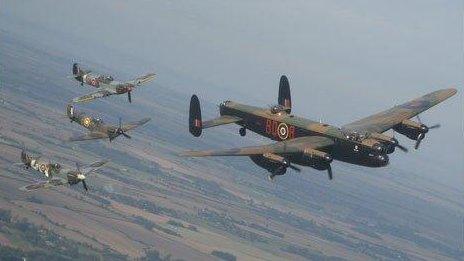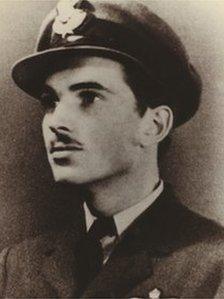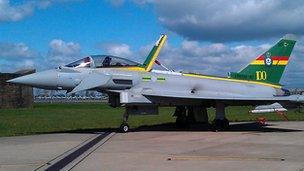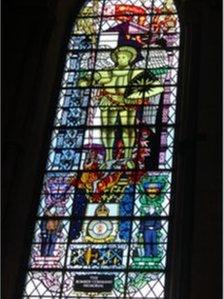'Bomber County' past and present
- Published

The Battle of Britain Memorial Flight is based in Lincolnshire
The centenary of the Royal Air Force's oldest squadron of aeroplanes was marked this month in Lincolnshire - an area so associated with the RAF it became known as Bomber County. But what is the significance now?
The small Lincolnshire village of Scopwick has no more than a few hundred residents, but for many people around the world it is a site of pilgrimage.
In the cemetery is the grave of John Gillespie Magee, who wrote the poem High Flight shortly before before being killed in a World War II flying accident.

Magee wrote High Flight after taking his Spitfire on a test flight
His poem lived on, becoming popular among aviators and being made the official poem of the Royal Canadian Air Force, in which Magee served.
"People come to visit his grave on a fairly frequent basis," said Rev David Woods, vicar for Holy Cross Church, Scopwick.
"Last year there was a contingent who came from Canada."
"I think some of the Magee family have been to visit the grave," he said. "And people from Scopwick have close connections with them."
The village is one of just many places in Lincolnshire with significance for aviators and military aviation enthusiasts.
The RAF now has six operational stations in the county, but during World War II there are thought to have been more than 100 military airfields, including dummy airfields and emergency landing strips.
Military historian Bruce Barrymore Halpenny said the exact number is not known because a lot of paperwork was destroyed after the war, but it is accepted that there were more than in any other county.
"At the outset of World War II the bulk of all bombers took off from Lincolnshire hence it, and it alone, became known as Bomber County," he said.
The county's proximity to Germany made it ideal for airfields, according to Harold Panton, who set up the Lincolnshire Aviation Heritage Centre.
The flatness of the county's farming land also made it well-suited, he said.
Mr Panton and his brother Fred set up the centre as a tribute to their brother Christopher, who was shot down and killed on a bombing raid over Nuremberg in March 1944.
It is based on the old wartime airfield of RAF East Kirkby, and is now a family-run museum with a collection of wartime vehicles including a Lancaster bomber.

One Typhoon at RAF Coningsby has been painted to mark 100 years of No 3 (Fighter) Squadron
Mr Barrymore Halpenny's research has shown that after the war many airfields were returned to their owners.
"There are still several abandoned buildings, especially the control towers that can be seen dotted around the county; haunting reminders to the past and the great sacrifice of so many brave men and women."
Lincolnshire's aviation heritage is also remembered through a display team called the Battle of Britain Memorial Flight, a collection of aircraft which includes Spitfires and Hurricanes.
Based at RAF Coningsby, the team performs across the UK, recently making an appearance at the wedding of Kate Middleton and Prince William, who himself learnt to fly at another of the county's air bases - RAF Cranwell.
But the most famous Lincolnshire display team is undoubtedly the Red Arrows, whose are based at RAF Scampton.
The base was previously home to the 617 Squadron, famously known as the Dambusters for their raids on German dams.
Lincolnshire is also the RAF's main home for the Typhoon jet, with four squadrons at Coningsby.

The Bomber Command window at Lincoln Cathedral dates from 1954
These include the No 3 (Fighter) Squadron, described as "oldest fixed-wing squadron" in the RAF - created by its forerunner, the Royal Flying Corps.
The "fixed wing" distinction means it was the first to exclusively operate aeroplanes, as the No 1 and No 2 squadrons used hot air balloons.
"There's a big argument as to who is the oldest," said Wing Commander Dicky Patounas, the current officer commanding No 3 (Fighter) Squadron.
"Three squadrons were formed on exactly the same day, 13 May 1912.
"No 1 was equipped with balloons only. No 2 was equipped with a mixture of balloons and aeroplanes, but we have only ever operated with aeroplanes."
In contrast, the RAF describes the Typhoon as its most modern and versatile multi-role aircraft, and it is these jets which will be used to provide security during the Olympics.
A memorial to Bomber Command personnel killed during World War II is due to be dedicated and unveiled in London on 28 June.
Bomber Command 'home'
There are also plans for one to be built in Lincoln, although the city's cathedral already has two such memorials.

The memorial stone at Lincoln Cathedral was unveiled in August 2006
One is a stained glass window in the Airmens' Chapel and the other is a memorial stone on the ground outside the Airmens' Chapel.
There is also a book which records the 26,911 names of the personnel stationed in Lincolnshire who died.
Duty chaplain Canon Michael Boughton said the cathedral is regularly visited by relatives of those who died.
"The ones that have actually flown are getting fewer but families come," he said.
"The thing I hear most as a duty chaplain is that the cathedral was a landmark for the people flying back to England, directing them they were very nearly home, and that's why they come back."
<italic>BBC Radio Lincolnshire will be exploring the county's aviation heritage when it broadcasts live from RAF Coningsby on Sunday 20 May, as part of its </italic> <link> <caption>One Week in Lincolnshire</caption> <url href="http://www.bbc.co.uk/news/uk-england-lincolnshire-17817763" platform="highweb"/> </link> <italic> project.</italic>
- Published2 May 2012
- Published25 April 2011